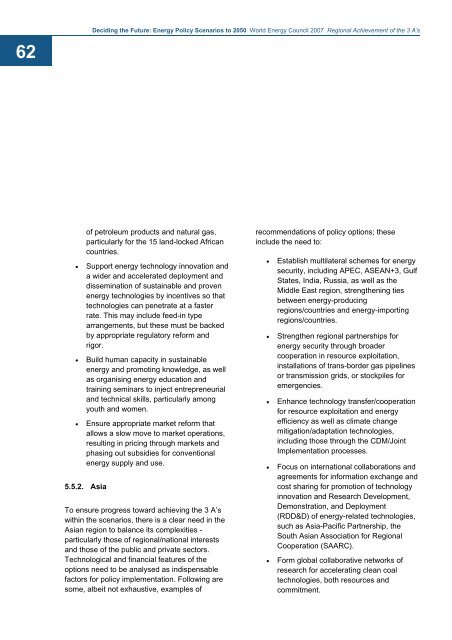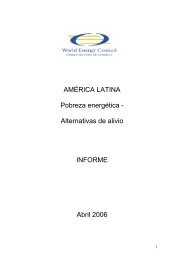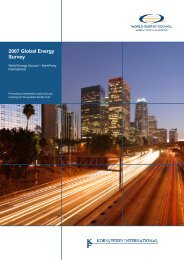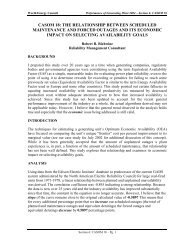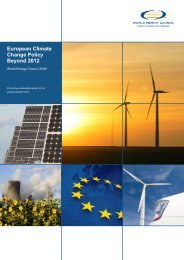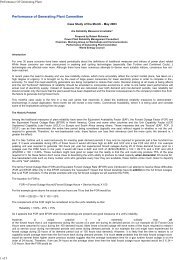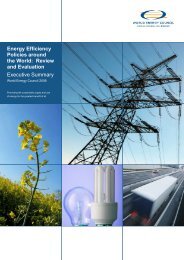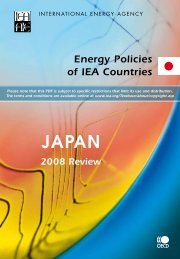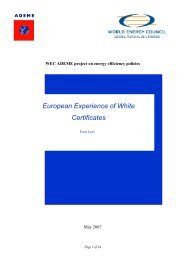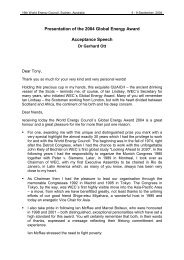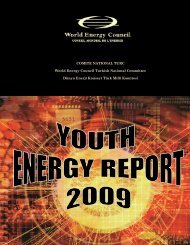Deciding the Future: Energy Policy Scenarios to 2050
Deciding the Future: Energy Policy Scenarios to 2050
Deciding the Future: Energy Policy Scenarios to 2050
Create successful ePaper yourself
Turn your PDF publications into a flip-book with our unique Google optimized e-Paper software.
62<br />
<strong>Deciding</strong> <strong>the</strong> <strong>Future</strong>: <strong>Energy</strong> <strong>Policy</strong> <strong>Scenarios</strong> <strong>to</strong> <strong>2050</strong> World <strong>Energy</strong> Council 2007 Regional Achievement of <strong>the</strong> 3 A’s<br />
of petroleum products and natural gas,<br />
particularly for <strong>the</strong> 15 land-locked African<br />
countries.<br />
• Support energy technology innovation and<br />
a wider and accelerated deployment and<br />
dissemination of sustainable and proven<br />
energy technologies by incentives so that<br />
technologies can penetrate at a faster<br />
rate. This may include feed-in type<br />
arrangements, but <strong>the</strong>se must be backed<br />
by appropriate regula<strong>to</strong>ry reform and<br />
rigor.<br />
• Build human capacity in sustainable<br />
energy and promoting knowledge, as well<br />
as organising energy education and<br />
training seminars <strong>to</strong> inject entrepreneurial<br />
and technical skills, particularly among<br />
youth and women.<br />
• Ensure appropriate market reform that<br />
allows a slow move <strong>to</strong> market operations,<br />
resulting in pricing through markets and<br />
phasing out subsidies for conventional<br />
energy supply and use.<br />
5.5.2. Asia<br />
To ensure progress <strong>to</strong>ward achieving <strong>the</strong> 3 A’s<br />
within <strong>the</strong> scenarios, <strong>the</strong>re is a clear need in <strong>the</strong><br />
Asian region <strong>to</strong> balance its complexities -<br />
particularly those of regional/national interests<br />
and those of <strong>the</strong> public and private sec<strong>to</strong>rs.<br />
Technological and financial features of <strong>the</strong><br />
options need <strong>to</strong> be analysed as indispensable<br />
fac<strong>to</strong>rs for policy implementation. Following are<br />
some, albeit not exhaustive, examples of<br />
recommendations of policy options; <strong>the</strong>se<br />
include <strong>the</strong> need <strong>to</strong>:<br />
• Establish multilateral schemes for energy<br />
security, including APEC, ASEAN+3, Gulf<br />
States, India, Russia, as well as <strong>the</strong><br />
Middle East region, streng<strong>the</strong>ning ties<br />
between energy-producing<br />
regions/countries and energy-importing<br />
regions/countries.<br />
• Streng<strong>the</strong>n regional partnerships for<br />
energy security through broader<br />
cooperation in resource exploitation,<br />
installations of trans-border gas pipelines<br />
or transmission grids, or s<strong>to</strong>ckpiles for<br />
emergencies.<br />
• Enhance technology transfer/cooperation<br />
for resource exploitation and energy<br />
efficiency as well as climate change<br />
mitigation/adaptation technologies,<br />
including those through <strong>the</strong> CDM/Joint<br />
Implementation processes.<br />
• Focus on international collaborations and<br />
agreements for information exchange and<br />
cost sharing for promotion of technology<br />
innovation and Research Development,<br />
Demonstration, and Deployment<br />
(RDD&D) of energy-related technologies,<br />
such as Asia-Pacific Partnership, <strong>the</strong><br />
South Asian Association for Regional<br />
Cooperation (SAARC).<br />
• Form global collaborative networks of<br />
research for accelerating clean coal<br />
technologies, both resources and<br />
commitment.


